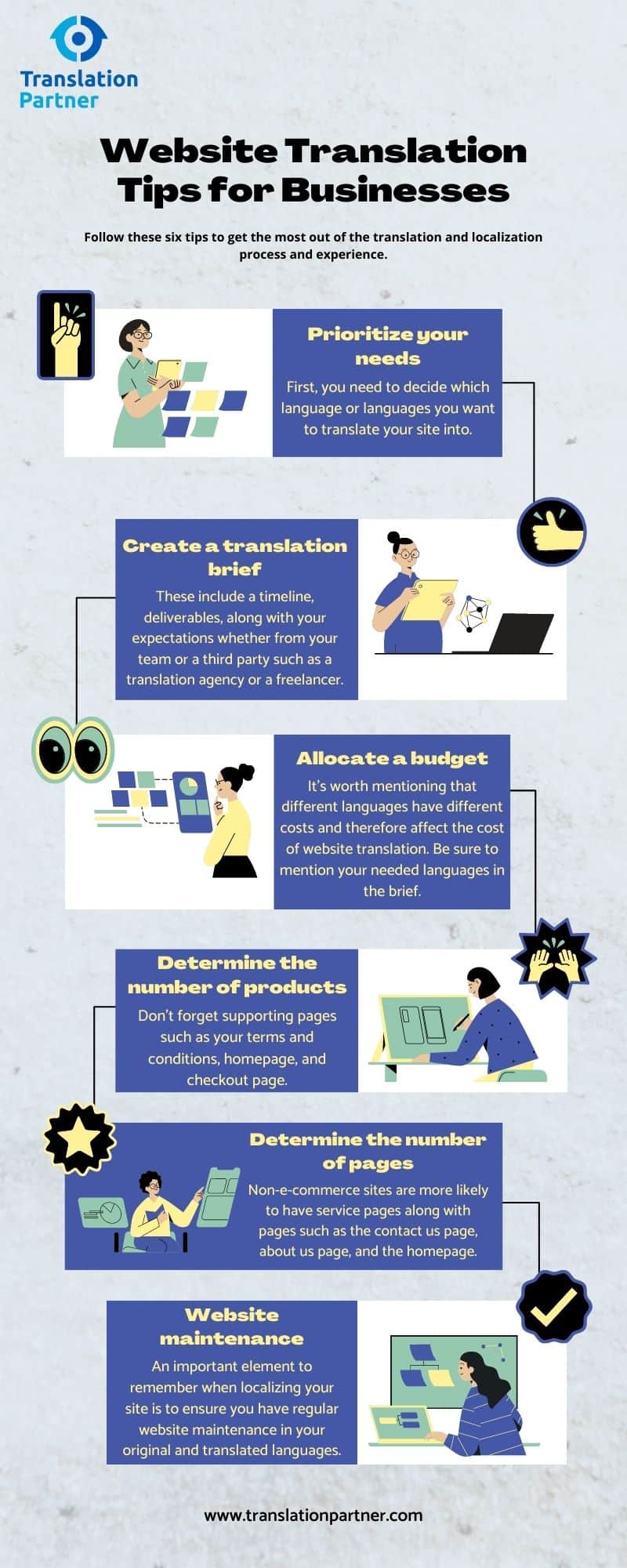Did you know that the global language services market has surpassed $5 billion in the past two years?
In 2019, the global language services market was estimated to be worth $49.6 billion. This figure jumped to $56.18 billion in 2021. (Statista)
It shouldn’t come as a surprise that in those two years health-related content, whether websites, blogs, educational content, e-books, or reports, topped demand.
According to Market Research Future, COVID-19 resulted in a 40% growth in the translation industry.
However, healthcare wasn’t the only industry or sector that required translation. Other notable sectors included e-commerce, marketing, and financial services, just to name a few.
To meet this growing demand, many businesses had to begin translating their websites and content.
Unfortunately, many struggled with the translation aspect because, in website translation, many elements come into play.
In this article, we’ll focus on the top elements businesses need to consider when considering website translation or localization.
The rising importance of translation
Despite its massive contribution to the translation industry, the coronavirus pandemic wasn’t the only factor that helped it grow.
Here are a few more factors:
The rising number of international schools in various countries, the need to learn English to find better jobs in one’s country or abroad, and the emergence of live-streaming apps such as Netflix have resulted in multicultural and multilingual audiences in many countries.
A top industry-growth contributor has been e-commerce.
Many online stores now need to have multilingual websites to expand their presence and cater to their growing audiences.
Whether through websites like Shopify or independent sites, e-commerce has helped many people shop from international stores.
The restrictions in travel starting in 2020, all the way through to some lockdowns in 2021 and 2022, have played a role in giving the translation industry a boost.
Many companies are now trying to build an international following so that they can attract customers once travel restrictions ease.
With many people forced to stay at home, along with more work-from-home needs, online searches have surged.
Moreover, with the coronavirus not seeming to end, more people are searching for medical content in their native languages, thereby calling for more translated and localized medical content.
Does your website need translation or localization?
Before you begin converting your site into another language, you must first understand the differences between translation and localization and determine which you’ll need for your website.
Translation is the process of transforming any piece of content, such as your website, into another language.
Localization, on the other hand, is an advanced form of translation that gives this piece of content a more local feel.
For example, if you’re translating your website into German, you may want to consider whether you’re targeting German speakers across Europe or those in Switzerland specifically.
If you decide to target German speakers in Switzerland, you’ll need to localize your website into Swiss German.
Bonus tip:
Working with a translation agency, like TranslationPartner, ensures that your website is translated by professional native speakers in your language of choice.
How do you know you’ve got international customers?
Before you embark on translating your website, you’ll first need to consider your target audience and their language.
Think about your website visitors!

You’re seeing traffic from international customers so you want to give them a reason to buy from you.
You want to be proactive by translating your website to expand your footprint into other countries and attract new customers.
So, how can you know if you’ve got an international audience or where they’re coming from?
By looking at data from your Google Analytics and Google Search Console.
Google Analytics gives website owners and marketers a snapshot of their web traffic, where visitors are coming from, bounce rate, the average time they spend on a site, along demographic information.
“The primary focus of Google Analytics is to interpret and process website usage data, identifying trends and opportunities you can leverage to increase traffic and boost your web presence,” explains RivalMind.
On the other hand, Google Search Console is a tool for webmasters that promotes success in search results…[It is] valuable for SEO marketers and web developers.” (RivalMind)
Google Search Console offers insights into search queries (what customers are looking for), incoming links from other sites, and crawling errors, among others.
While these metrics “have little to do with who” visits your website, they offer information about how your site appears to customers and searchers.
Using Google Search Console will also help you discover problem areas in your website and indicate areas for improvement.
Bonus tip:
If you’re just starting out, before sure to integrate both free apps: Google Search Console and Google Analytics into your website.
The Exakt Health Case Study
Exakt Health is an app that helps people and athletes recover from sports injuries.
Launched in August 2021 in Berlin, Exakt Health was primarily focused on serving English-speaking European customers. However, they discovered that their traffic came from other countries such as Spain and France, and that people were struggling because the app was only available in English.
That’s why Exakt Health decided to localize its website and mobile app. They added French, German, and Spanish to support their target audience’s needs and expand their customer base.
Website translation tips for businesses
You’re probably wondering how to go about the website translation process.

Follow these six tips to get the most out of the translation and localization process and experience.
1) Prioritize your needs
First, you need to decide which language or languages you want to translate your site into.
You can start with a single language or several. It depends on your needs and budget.
2) Create a translation brief
An important step is to create a brief. Like a marketing brief, the translation brief will help you flesh out all your needs and the details pertaining to your project.
These include a timeline, deliverables, along with your expectations whether from your team or a third party such as a translation agency or a freelancer.
3) Allocate a budget
Before beginning the website translation process, you’ll need to determine how much you’ll spend.
It’s worth mentioning that different languages have different costs and therefore affect the cost of website translation. Be sure to mention your needed languages in the brief.
Bonus tip:
Use your translation brief to get quotes from agencies and freelancers to gauge the cost of the project.
4) Determine the number of products
If you’re an e-commerce business, you’ll need to determine the number of products (or product pages).
Don’t forget supporting pages such as your terms and conditions, homepage, and the checkout page.
Determining the number and content of these pages will help your team or the third party estimate the time they need and the cost of translating your site.
This also applies to Shopify store translation. And with Shopify, you can either use one of their Shopify translation apps or hire a third party to translate your store.
5) Determine the number of pages
Non-e-commerce sites are more likely to have service pages along with pages such as the contact us page, about us page, and the homepage.
Other pages can include the blog, privacy policy, terms, and conditions, among many others.
6) Website maintenance
An important element to remember when localizing your site is to ensure you have regular website maintenance in your original and translated languages.
This ensures that you don’t fall into any problems with SEO, website speed, crawling, and other technical issues.
Final words
Like any form of translation, there are best practices for website translation.
And it’s important to be aware of these best practices to ensure a smooth process and effective translation and result.
Some of these best practices mean you need to be aware of what SEO translation, which help you rank on Google in different languages. This means that your team or third party needs to be aware of multilingual SEO best practices.
You don’t want to translate your website with a ‘let’s translate it now in any way possible and fix it later’ mindset.
This mindset comes with disastrous consequences, especially since websites have to conform with Google’s best practices.
Need help translating or localizing your website into different languages? Get in touch with TranslationPartner and our team will answer all your questions and help you create your translation brief.

